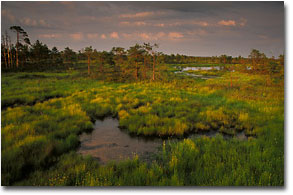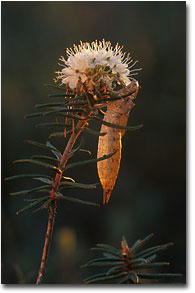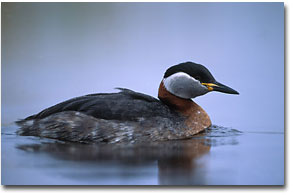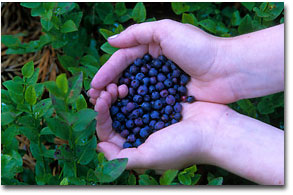 It is a dazzling September evening as we weave further into the bog to look
at an area of pines scorched in a lightning-inspired fire last year. I brush
past a clump of Labrador tea, its tangy scent evoking calm June evenings,
and feel the bristly ground yield more with each step. Over the top of my
sunglasses, I look to where the yellow sedges point to a pool the colour of
stewed tea, and to the crisp pines beyond. I take one more step and
suddenly am going down. As I sink into the unseen pool, I recall in an
instant everything I have in my pack - all my camera gear, passport,
currency, flight tickets. Down to my chest now, warm but unchecked then, in
an instant up again, brown flecked elbows and forearms pressing into the
comforting Sphagnum as Janis recovers me. The alarm is more on the part of
my Latvian friends - once I realise that everything inside the pack has
stayed dry; a spark of connection with this wild place has been ignited,
rather than extinguished, by the baptism.
It is a dazzling September evening as we weave further into the bog to look
at an area of pines scorched in a lightning-inspired fire last year. I brush
past a clump of Labrador tea, its tangy scent evoking calm June evenings,
and feel the bristly ground yield more with each step. Over the top of my
sunglasses, I look to where the yellow sedges point to a pool the colour of
stewed tea, and to the crisp pines beyond. I take one more step and
suddenly am going down. As I sink into the unseen pool, I recall in an
instant everything I have in my pack - all my camera gear, passport,
currency, flight tickets. Down to my chest now, warm but unchecked then, in
an instant up again, brown flecked elbows and forearms pressing into the
comforting Sphagnum as Janis recovers me. The alarm is more on the part of
my Latvian friends - once I realise that everything inside the pack has
stayed dry; a spark of connection with this wild place has been ignited,
rather than extinguished, by the baptism.
I have been in the bogs of eastern Latvia in March when snow conceals the
generations-old paths of cranberry pickers and it’s hard to know just where
you are. In May, west of Riga, jumpy wood sandpipers have voiced their
concerns to me from stunted pine snags, while below, the stone cold water
reflects piling cumulus.
 The “purvs” draw me back at all times of year by their wildness, their
antiquity, their apparent intractability. For where in Latvia would the
water drain to – the country is mostly very low lying? For all the Soviet¹s legacy of shattered family trees, grim utilitarianism and colonisation, they bequeathed to the restored Republic of Latvia a network of biologically-rich protected areas -
and highly educated biologists - which we in the UK might envy. By 1985, 6
years before independence, 5 % of Latvia was under state protection -
including, according to the Latvian SSR Red Data Book for that year, 61
cranberry sanctuaries; areas of bog. Now, as part of the political process
to accede to the EU, strenuous efforts are being made to conform to EU
habitat and species directives. Bureaucrats, on paper at least, are on the
side of the bogs and in Kemeri National Park and Teici Nature Reserve (at 19
337 ha, the largest protected bog in the Baltic), Latvia has two of the most
important examples of lowland raised bogs left in Europe.
The “purvs” draw me back at all times of year by their wildness, their
antiquity, their apparent intractability. For where in Latvia would the
water drain to – the country is mostly very low lying? For all the Soviet¹s legacy of shattered family trees, grim utilitarianism and colonisation, they bequeathed to the restored Republic of Latvia a network of biologically-rich protected areas -
and highly educated biologists - which we in the UK might envy. By 1985, 6
years before independence, 5 % of Latvia was under state protection -
including, according to the Latvian SSR Red Data Book for that year, 61
cranberry sanctuaries; areas of bog. Now, as part of the political process
to accede to the EU, strenuous efforts are being made to conform to EU
habitat and species directives. Bureaucrats, on paper at least, are on the
side of the bogs and in Kemeri National Park and Teici Nature Reserve (at 19
337 ha, the largest protected bog in the Baltic), Latvia has two of the most
important examples of lowland raised bogs left in Europe.
I am drawn back. It is easy in some of the bogs to imagine that you are the
first to press their spongy surface, especially in summer when it is
possible to penetrate deep within. The illusion is heightened by the loss
of a horizon as water-dwarfed pines crowd around. Disorientation comes
easily here. The lucky pines find small islands of mineral soil and grow
without the stoop induced by physiological drought and anaerobia. Here too
are refuges for wolves who also may sense isolation in the bogs, sometimes
using the islands to den in. Even people have found sanctuary here. The
island of Siksala in Teici, is home to a community of Old Believers. The
absolutism which has characterised much of modern Russian history has long,
deep roots and was manifest in Peter the Great’s persecution of those who
didn’t subscribed to the new doctrine following a 17th century schism in the
Russian Orthodox church. In Siksala, in the middle of a wild bog, the Old
Believers found peace to worship.
 For many modern Latvians - town and country people - bogs are not wasteland, or obstacle but enjoyable places to visit. You are almost certainly not the first to pass this way. People come to gather cloudberries and cranberries and to hunt elk, geese and black grouse. They may even come to swim in the warm, murky pools. There is a refreshing lack of preciousness in the Latvian attitude to wild nature, a sense that it is there to be enjoyed through restrained
use rather than held in awe at arm’s length. Wildflowers are gathered. Fur
is worn. Wild game is eaten. The relatively recent (in British terms, at
least) transition from agrarian to industrialised society deeply informs
sensibilities towards nature and even cultural disposition towards
expressions of that link with the land. For example, the surnames of many
Latvians are the words for different species of birds or trees - my friend
Janis Ozolins is John Littleoak. At the weekends, Riga grows quieter as
residents head to their summer cottages in the country. During the Soviet
occupation, the oak (the male tree) and lime (the female) were reaffirmed
as powerful symbols of Latvian national identity and several massive
specimen oaks were dynamited - ostensibly for agricultural reasons but with
a consequential demoralising effect too. I believe that this practical
engagement with wild places (such as bogs) offers them the best protection
from those who value them only for the money their peat could realise.
For many modern Latvians - town and country people - bogs are not wasteland, or obstacle but enjoyable places to visit. You are almost certainly not the first to pass this way. People come to gather cloudberries and cranberries and to hunt elk, geese and black grouse. They may even come to swim in the warm, murky pools. There is a refreshing lack of preciousness in the Latvian attitude to wild nature, a sense that it is there to be enjoyed through restrained
use rather than held in awe at arm’s length. Wildflowers are gathered. Fur
is worn. Wild game is eaten. The relatively recent (in British terms, at
least) transition from agrarian to industrialised society deeply informs
sensibilities towards nature and even cultural disposition towards
expressions of that link with the land. For example, the surnames of many
Latvians are the words for different species of birds or trees - my friend
Janis Ozolins is John Littleoak. At the weekends, Riga grows quieter as
residents head to their summer cottages in the country. During the Soviet
occupation, the oak (the male tree) and lime (the female) were reaffirmed
as powerful symbols of Latvian national identity and several massive
specimen oaks were dynamited - ostensibly for agricultural reasons but with
a consequential demoralising effect too. I believe that this practical
engagement with wild places (such as bogs) offers them the best protection
from those who value them only for the money their peat could realise.
 It is July now. My guide and I lounge on a board walk snaking through the
Kemeri bog watching the clouds colour up at sunset. Suddenly I sit up.
Where are the insects? I realise that we¹ve been sitting here for the last
twenty minutes and haven¹t been courted by a single mosquito. “It’s too
open for them here, “she tells me,” And besides, there aren’t many other
meals here except us. Relax.” Considering that earlier in the week, I’d had
to wear a head net while swimming in a river to protect myself from cleggs
(and still was bitten underwater!) and mosquitoes, this is reassuring. But
I relax. Deeper into the bog than it is possible to reach without webbed
feet we hear the slightly metallic symphonics of a crane family, a sound
that, in the dead calm, reverberates off the tall pines at the edge of the bog way behind us. Bilberry fingered, I point to three whimbrel which trill overhead - perhaps early migrants moving south from their breeding grounds. On its last patrol before night fall a dragonfly clatters past, a dry, ancient sound from the Jurassic. To the high bugling of the cranes is now added a bass line as thunder rumbles like distant shed doors. Must get
back to the woods now. Back to the scents of the night and a final feast of
sweet bilberries.
It is July now. My guide and I lounge on a board walk snaking through the
Kemeri bog watching the clouds colour up at sunset. Suddenly I sit up.
Where are the insects? I realise that we¹ve been sitting here for the last
twenty minutes and haven¹t been courted by a single mosquito. “It’s too
open for them here, “she tells me,” And besides, there aren’t many other
meals here except us. Relax.” Considering that earlier in the week, I’d had
to wear a head net while swimming in a river to protect myself from cleggs
(and still was bitten underwater!) and mosquitoes, this is reassuring. But
I relax. Deeper into the bog than it is possible to reach without webbed
feet we hear the slightly metallic symphonics of a crane family, a sound
that, in the dead calm, reverberates off the tall pines at the edge of the bog way behind us. Bilberry fingered, I point to three whimbrel which trill overhead - perhaps early migrants moving south from their breeding grounds. On its last patrol before night fall a dragonfly clatters past, a dry, ancient sound from the Jurassic. To the high bugling of the cranes is now added a bass line as thunder rumbles like distant shed doors. Must get
back to the woods now. Back to the scents of the night and a final feast of
sweet bilberries.
|
Photographers for Latvia 2002
May 2002 saw the first gathering of professional nature photographers from
Norway, Scotland, the Netherlands, France, Germany and Italy to shoot
pictures of Latvia for its main conservation NGO, the Latvian Ornothological
Society and to illustrate features about the country for their domestic
publications about the biological riches of the country. There remains
tremendous scope for photographers from different countries to cooperate
with local biologists to raise the international profile of species and
conservation issues in overlooked parts of the world.
|
Niall Benvie - NPN 018
Comments on NPN nature photography articles? Send them to the editor.

 It is a dazzling September evening as we weave further into the bog to look
at an area of pines scorched in a lightning-inspired fire last year. I brush
past a clump of Labrador tea, its tangy scent evoking calm June evenings,
and feel the bristly ground yield more with each step. Over the top of my
sunglasses, I look to where the yellow sedges point to a pool the colour of
stewed tea, and to the crisp pines beyond. I take one more step and
suddenly am going down. As I sink into the unseen pool, I recall in an
instant everything I have in my pack - all my camera gear, passport,
currency, flight tickets. Down to my chest now, warm but unchecked then, in
an instant up again, brown flecked elbows and forearms pressing into the
comforting Sphagnum as Janis recovers me. The alarm is more on the part of
my Latvian friends - once I realise that everything inside the pack has
stayed dry; a spark of connection with this wild place has been ignited,
rather than extinguished, by the baptism.
It is a dazzling September evening as we weave further into the bog to look
at an area of pines scorched in a lightning-inspired fire last year. I brush
past a clump of Labrador tea, its tangy scent evoking calm June evenings,
and feel the bristly ground yield more with each step. Over the top of my
sunglasses, I look to where the yellow sedges point to a pool the colour of
stewed tea, and to the crisp pines beyond. I take one more step and
suddenly am going down. As I sink into the unseen pool, I recall in an
instant everything I have in my pack - all my camera gear, passport,
currency, flight tickets. Down to my chest now, warm but unchecked then, in
an instant up again, brown flecked elbows and forearms pressing into the
comforting Sphagnum as Janis recovers me. The alarm is more on the part of
my Latvian friends - once I realise that everything inside the pack has
stayed dry; a spark of connection with this wild place has been ignited,
rather than extinguished, by the baptism. The “purvs” draw me back at all times of year by their wildness, their
antiquity, their apparent intractability. For where in Latvia would the
water drain to – the country is mostly very low lying? For all the Soviet¹s legacy of shattered family trees, grim utilitarianism and colonisation, they bequeathed to the restored Republic of Latvia a network of biologically-rich protected areas -
and highly educated biologists - which we in the UK might envy. By 1985, 6
years before independence, 5 % of Latvia was under state protection -
including, according to the Latvian SSR Red Data Book for that year, 61
cranberry sanctuaries; areas of bog. Now, as part of the political process
to accede to the EU, strenuous efforts are being made to conform to EU
habitat and species directives. Bureaucrats, on paper at least, are on the
side of the bogs and in Kemeri National Park and Teici Nature Reserve (at 19
337 ha, the largest protected bog in the Baltic), Latvia has two of the most
important examples of lowland raised bogs left in Europe.
The “purvs” draw me back at all times of year by their wildness, their
antiquity, their apparent intractability. For where in Latvia would the
water drain to – the country is mostly very low lying? For all the Soviet¹s legacy of shattered family trees, grim utilitarianism and colonisation, they bequeathed to the restored Republic of Latvia a network of biologically-rich protected areas -
and highly educated biologists - which we in the UK might envy. By 1985, 6
years before independence, 5 % of Latvia was under state protection -
including, according to the Latvian SSR Red Data Book for that year, 61
cranberry sanctuaries; areas of bog. Now, as part of the political process
to accede to the EU, strenuous efforts are being made to conform to EU
habitat and species directives. Bureaucrats, on paper at least, are on the
side of the bogs and in Kemeri National Park and Teici Nature Reserve (at 19
337 ha, the largest protected bog in the Baltic), Latvia has two of the most
important examples of lowland raised bogs left in Europe. For many modern Latvians - town and country people - bogs are not wasteland, or obstacle but enjoyable places to visit. You are almost certainly not the first to pass this way. People come to gather cloudberries and cranberries and to hunt elk, geese and black grouse. They may even come to swim in the warm, murky pools. There is a refreshing lack of preciousness in the Latvian attitude to wild nature, a sense that it is there to be enjoyed through restrained
use rather than held in awe at arm’s length. Wildflowers are gathered. Fur
is worn. Wild game is eaten. The relatively recent (in British terms, at
least) transition from agrarian to industrialised society deeply informs
sensibilities towards nature and even cultural disposition towards
expressions of that link with the land. For example, the surnames of many
Latvians are the words for different species of birds or trees - my friend
Janis Ozolins is John Littleoak. At the weekends, Riga grows quieter as
residents head to their summer cottages in the country. During the Soviet
occupation, the oak (the male tree) and lime (the female) were reaffirmed
as powerful symbols of Latvian national identity and several massive
specimen oaks were dynamited - ostensibly for agricultural reasons but with
a consequential demoralising effect too. I believe that this practical
engagement with wild places (such as bogs) offers them the best protection
from those who value them only for the money their peat could realise.
For many modern Latvians - town and country people - bogs are not wasteland, or obstacle but enjoyable places to visit. You are almost certainly not the first to pass this way. People come to gather cloudberries and cranberries and to hunt elk, geese and black grouse. They may even come to swim in the warm, murky pools. There is a refreshing lack of preciousness in the Latvian attitude to wild nature, a sense that it is there to be enjoyed through restrained
use rather than held in awe at arm’s length. Wildflowers are gathered. Fur
is worn. Wild game is eaten. The relatively recent (in British terms, at
least) transition from agrarian to industrialised society deeply informs
sensibilities towards nature and even cultural disposition towards
expressions of that link with the land. For example, the surnames of many
Latvians are the words for different species of birds or trees - my friend
Janis Ozolins is John Littleoak. At the weekends, Riga grows quieter as
residents head to their summer cottages in the country. During the Soviet
occupation, the oak (the male tree) and lime (the female) were reaffirmed
as powerful symbols of Latvian national identity and several massive
specimen oaks were dynamited - ostensibly for agricultural reasons but with
a consequential demoralising effect too. I believe that this practical
engagement with wild places (such as bogs) offers them the best protection
from those who value them only for the money their peat could realise. It is July now. My guide and I lounge on a board walk snaking through the
Kemeri bog watching the clouds colour up at sunset. Suddenly I sit up.
Where are the insects? I realise that we¹ve been sitting here for the last
twenty minutes and haven¹t been courted by a single mosquito. “It’s too
open for them here, “she tells me,” And besides, there aren’t many other
meals here except us. Relax.” Considering that earlier in the week, I’d had
to wear a head net while swimming in a river to protect myself from cleggs
(and still was bitten underwater!) and mosquitoes, this is reassuring. But
I relax. Deeper into the bog than it is possible to reach without webbed
feet we hear the slightly metallic symphonics of a crane family, a sound
that, in the dead calm, reverberates off the tall pines at the edge of the bog way behind us. Bilberry fingered, I point to three whimbrel which trill overhead - perhaps early migrants moving south from their breeding grounds. On its last patrol before night fall a dragonfly clatters past, a dry, ancient sound from the Jurassic. To the high bugling of the cranes is now added a bass line as thunder rumbles like distant shed doors. Must get
back to the woods now. Back to the scents of the night and a final feast of
sweet bilberries.
It is July now. My guide and I lounge on a board walk snaking through the
Kemeri bog watching the clouds colour up at sunset. Suddenly I sit up.
Where are the insects? I realise that we¹ve been sitting here for the last
twenty minutes and haven¹t been courted by a single mosquito. “It’s too
open for them here, “she tells me,” And besides, there aren’t many other
meals here except us. Relax.” Considering that earlier in the week, I’d had
to wear a head net while swimming in a river to protect myself from cleggs
(and still was bitten underwater!) and mosquitoes, this is reassuring. But
I relax. Deeper into the bog than it is possible to reach without webbed
feet we hear the slightly metallic symphonics of a crane family, a sound
that, in the dead calm, reverberates off the tall pines at the edge of the bog way behind us. Bilberry fingered, I point to three whimbrel which trill overhead - perhaps early migrants moving south from their breeding grounds. On its last patrol before night fall a dragonfly clatters past, a dry, ancient sound from the Jurassic. To the high bugling of the cranes is now added a bass line as thunder rumbles like distant shed doors. Must get
back to the woods now. Back to the scents of the night and a final feast of
sweet bilberries.